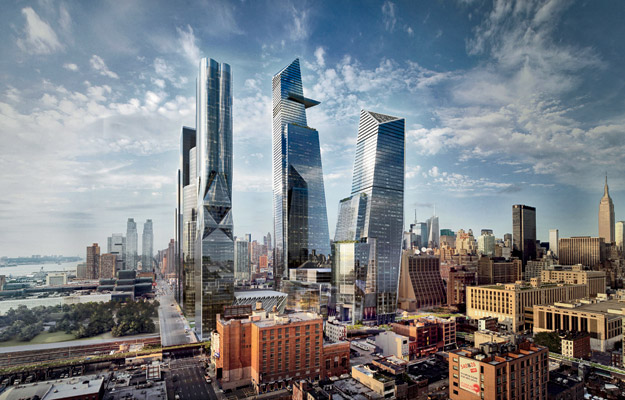Dear Mayor Bill de Blasio:
Along with many other architects and urbanists, I'm looking forward to your taking office this month as mayor of New York City, and working to implement the theme of your campaign, the elimination of the increasingly radical disparities that underlie that 'tale of two cities' you so frequently spoke about—a tale, increasingly, about two nations. While this program of social equity must operate in many spheres—from the creation of jobs to the provision of services, to the fight for environmental and social justice—planning the physical city in its growth and transformation is one of the most important powers of municipal government, one that the Bloomberg administration has deployed with stark effectiveness.

Perhaps the most disingenuous remark of the campaign was Mayor Bloomberg's comment that our obscene income gap was the product not of a rise in poverty but of a wave of immigrant billionaires, and the more the better. As he put it, 'The reason it's so big is, at the higher end, we've been able to do something that none of these other cities can do, and that is attract a lot of the very wealthy from around the country and around the world.' While hospitality to strivers is a hallmark of New York's greatness, we've been too long governed by a theory that has trickle-down as its normative center. Indeed, if all wealth descends from the top, the logic of development must have as its predicate making the rich as rich as can be—and much of the planning process in recent years has sought to do precisely that. From corporatist development priorities to sweepingly reconfigured zoning, a mind-set that filters urban construction through the ideals of the real-estate industry has ruled.
Bloomberg's massive rezoning'his biggest planning move'is a form of urban stop and frisk falling disproportionately on minorities. According to the Furman Center at New York University, under the new regulations 'up-zoned lots tended to be located in census tracts with a higher proportion of nonwhite residents than the median tract in the city. Down-zoned lots, on the other hand, were more likely to be located in tracts with a higher share of non-Hispanic white residents than the city median, and contextual-only rezoned lots were located in areas with still higher shares of non-Hispanic white residents.'
Selling off libraries on valuable property, commercializing parks by demanding they be self-financing, building 'market rate' projects on Housing Authority lots, and zoning distorted by race and class, all speak to a triumph of means over ends, touted as a great public-private 'partnership': all symptoms of the great national post-Reagan turn against government. While Bloomberg has done many worthy things'for the environment, for transportation, for parks'his signature will indelibly be a vision of the luxurious center, Hudson Yards mixed-use development in the West Midtown area of Manhattan or the 'Billionaires Row' rising around 57th Street, where sky-high condos are selling for $50 million a pop. It is not a vision of our complex, often struggling fringe.
It's time to reintroduce communities into the planning process. New York must move beyond the oppositional model of planning that has too long dominated, best exemplified by our beloved Manichean struggle between cardboard versions of Robert Moses and Jane Jacobs. Although there is no contradiction in planning both inductively and deductively, our process is too skewed toward money and away from people: the capacity of neighborhoods to meaningfully participate in planning their own destinies—and that of the larger realms we all share—is fundamental. Wisdom doesn't belong to any particular group (although needs are best assessed locally), and a mayor must empower everyone. For this, we look to you with high hopes.
When the New York City charter was revised in 1989, it created a system of community boards and a medium of participation (the 197-a plan) that promised a new way of making decisions that would channel ideas from the grassroots to the top. But, despite the completion of many such plans across the city (out of 59 community boards, only 11 plans have ever been adopted) and despite the deep engagement of citizens and neighborhood groups in working toward ameliorative transformation, these efforts have never had real legal standing and depend on the sanction of a recalcitrant planning department. Let the de Blasio planning department pay better attention, return to the task of physical planning attuned to local desires, and more aggressively pursue architecturally significant outcomes. Instead of simply being the adjudicators of the circumstances for construction, our planners should produce more facts, more designs—and should set priorities that are both concrete and truly visionary.
This means displacing zoning as the primary instrument of planning. The logic of zoning—the idea that development best takes place 'as of right,' with clear rules, formulas, and frameworks—has a certain, nominally libertarian, appeal. What's concealed, though, is the structure of constraint that defines the territory in which those rules operate, whether via prescribed uses and densities or the smorgasbord of incentives and exceptions that a canny operator can call upon to enlarge a project in exchange for some marginal public benefit. We must ask as of whose rights all this complexity is designed to defend. In the postindustrial city, much of the basis for zoning is simply obsolete, and the 19th-century model of isolating obnoxious uses and classes from more privileged ones tends to make concrete exactly the kinds of differences you seek to erase.
For the past dozen years, the real power to plan has resided with the city's Economic Development Corporation, which, operating more like a private entity than a city agency, stands outside full scrutiny and control and acts as the mayor's creature. This tilt toward understanding government's role primarily as the facilitator of private initiatives has special consequences for the public realm—a space shared by the city's many publics—and it's time for a more transparent use of public money. There's something dispiriting about celebrating the fact that the beautiful Brooklyn Bridge Park was produced not by the Parks Department but by a special corporation financed by the inclusion of superluxe condos and a hipster hotel within it. Forcing the public realm to effectively produce its own revenues on the spot is a formula for assuring that the best public spaces will be in neighborhoods that can most afford them. The role of planning should be to equalize opportunity and community assets, and any system that either privatizes revenue collection or steers it too locally risks deepening the rift between our 'two cities.'
Since last year's Superstorm Sandy shut down the city, the idea of dramatically increasing New York's resiliency has been vigorously discussed; this is a project that engages everyone. Here's a point of entry to real planning that would serve all of the city and give municipal planners a truly comprehensive project for improving and strengthening both the social and the physical realms. The city must be dramatically reshaped in response to the planetary emergency of which Sandy was a symptom. We need to re-understand not just our coastlines, but our sewers, our energy supply, our ways of building. We need to rethink how we move, deal with our waste, and distribute our municipal assets, throughout the city. But resiliency is not simply a matter of the 'environment': it's a human necessity. With homelessness at all-time highs and housing prices prohibitive, we must build massively for those in need.
Mayor de Blasio, your idea of a mandate for inclusionary zoning begins to address this crisis yet continues to depend on the tender mercies of private developers to actually produce the units. If you are going to tax them, why not collect the money, municipalize the program, and make gorgeous, genuinely affordable housing your greatest legacy, building it where it's most needed? We can do it! In the parlous interwar years in Vienna, that little metropolis constructed apartments for almost a quarter-million working-class people, housing them in some of the finest architecture of all time. Why can't the greatest, richest city in the world do the same? Your massive electoral majority suggests that New York is ready for a restoration of democratic ideals about the role of government in directly bettering the lives of citizens. That's the kind of public-private partnership I could get behind!


Post a comment to this article
Report Abusive Comment